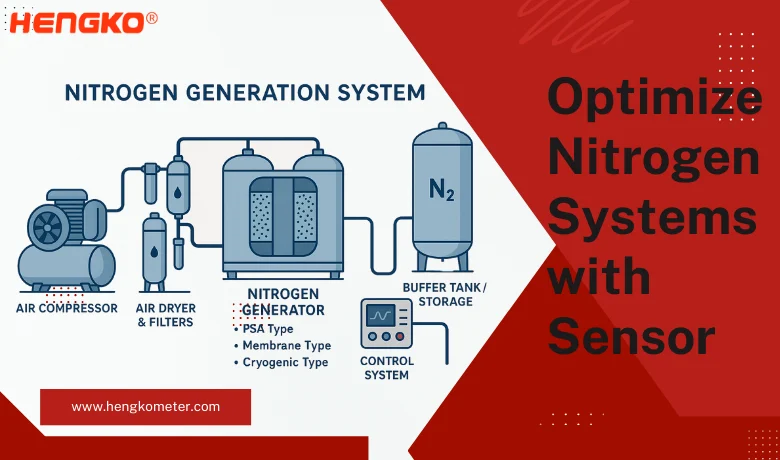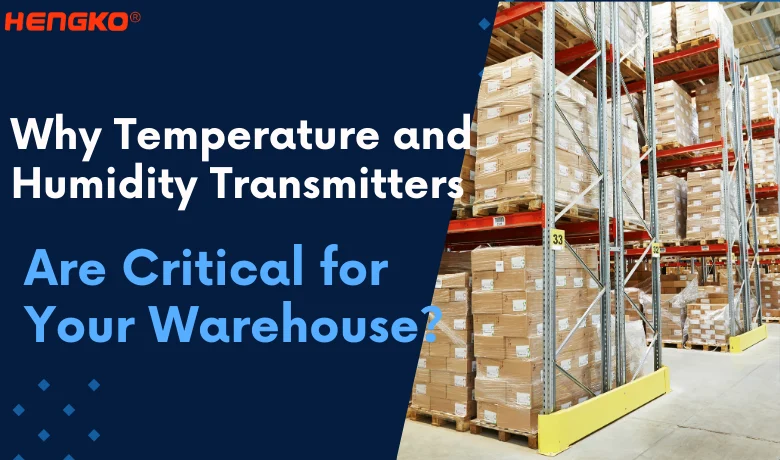Temp&RHセンサーソリューションで窒素システムを最適化

空気分離窒素生成システムにおいて、高純度ガスの出力は、コンプレッサー、ドライヤー、PSAタワーなどの中核部品だけではありません。見過ごされがちな要因として、システム効率、ガス純度、機器寿命が静かに損なわれることがあります。吸入時の過度の湿度から吸着時の温度変動まで、環境条件は窒素製造のあらゆる段階に影響します。そのため、温度と湿度のモニタリングは、保護だけでなく、性能の最適化にも威力を発揮します。窒素生成システムとは?窒素生成システムは、通常、圧力スイング吸着(PSA)、膜分離、または極低温空気分離などの方法を使用して、周囲の空気から高純度の窒素ガスを生成する産業用セットアップです。[...]
グローブボックス内のスマートモニタリング:露点、温度、湿度

はじめに 不活性雰囲気ボックスや隔離チャンバーとしても知られるグローブボックスは、汚染管理が重要な実験室や産業環境で重要な役割を果たしています。リチウム電池材料、高感度有機化合物、精密半導体のいずれを扱う場合でも、グローブボックス内の厳密な環境制御の維持は不可欠です。この制御の中核となるのが、温度、相対湿度、露点の3つの主要パラメータの正確なモニタリングです。この記事では、温度・湿度トランスミッタ、特に露点検出が可能なトランスミッタがグローブボックス・アプリケーションでどのように使用されているのか、どのような課題の解決に役立つのか、そして両プロセスを保護する適切なモニタリング・ソリューションの選択方法についてご紹介します。
製紙業界で高湿度トランスミッタが不可欠な理由

製紙業界の厳しい環境では、高湿度は一般的なことではなく、避けられないことです。パルプ化段階から乾燥工程、さらには保管場所に至るまで、湿度レベルはしばしば90%を超え、高温や腐食性の化学蒸気を伴います。ほとんどの電子センサーにとって、これは急速な故障のもとです。プロセスの安定性を維持し、紙の品質を保証するために、メーカーは温度と湿度を正確にモニターする必要があります。そこで、高湿度温湿度トランスミッタが不可欠となります。これらの堅牢なセンサーは、飽和空気環境でもドリフトや経時劣化を起こすことなく確実に動作するよう特別に設計されています。 製紙工場における湿度の課題 製紙工場の各工程では、湿度管理は重要な課題です。
半導体製造における環境トランスミッタ使用のトップメリット

Introduction In the highly sensitive world of semiconductor manufacturing, where even a minor environmental fluctuation can compromise millions of dollars’ worth of product, precise control over production conditions is non-negotiable. Among the most critical environmental parameters are temperature and humidity. This is where temperature and humidity transmitters come into play. These devices continuously monitor and transmit accurate data, ensuring stable environmental conditions throughout every phase of semiconductor production. This article explores the vital roles these transmitters play in semiconductor facilities—from cleanroom control to equipment protection—and highlights their irreplaceable value in ensuring product quality, yield, and operational efficiency. The Critical Role of Environmental Conditions in Semiconductor Manufacturing Semiconductor devices are made […]
バッテリー製造における温湿度トランスミッタの役割

In the modern age of technological advancements, the demand for batteries—especially lithium-ion batteries—has skyrocketed. These energy sources are integral to a wide range of applications, including consumer electronics, electric vehicles, and renewable energy storage systems. To ensure the optimal performance, safety, and longevity of these batteries, temperature and humidity management during their manufacturing process is of paramount importance. This is where temperature and humidity transmitters (TH transmitters) come into play, offering an essential solution for precise monitoring and control. In this article, we will explore the crucial role of temperature and humidity transmitters in battery manufacturing and their significant impact on battery quality. 1. The Importance of Temperature and Humidity […]
温湿度トランスミッタの校正方法

Introduction Temperature and humidity sensors play a crucial role in various industries, including environmental monitoring, HVAC systems, industrial automation, and agriculture. However, over time, these sensors may drift from their original accuracy due to aging, environmental exposure, or physical wear. Calibration is the process of adjusting the sensor to match a known reference, ensuring its readings remain accurate and reliable. In this guide, we will walk you through the importance of calibration, different methods, and a step-by-step process to properly calibrate your temperature and humidity sensors for optimal performance. Understanding Sensor Calibration What Is Calibration? Calibration is the process of adjusting a sensor’s output to match a known reference value. […]
センサーハウジングの究極ガイド:保護、素材、選択

Introduction Sensor housing is essential for protecting sensors from environmental challenges like moisture, dust, and extreme temperatures, ensuring accuracy and durability. With various materials and types available, choosing the right housing is key to optimizing sensor performance. This guide explores the role of sensor housing and provides tips for selecting the best option for your application. Why You Should Use Sensor Housing? 1. Protection Against Environmental Factors Sensors are often exposed to harsh conditions, including moisture, dust, chemicals, and extreme temperatures. A well-designed housing shields sensitive sensor components from these elements, preventing malfunctions and extending their lifespan. 2. Enhanced Measurement Accuracy External interference, such as electromagnetic noise, temperature fluctuations, or […]
なぜ4-20mAが最もポピュラーな信号出力なのか?

Introduction In the world of industrial sensors, temperature and humidity transmitters play a critical role in monitoring and controlling environmental conditions. Among the various signal output options available, the 4-20mA current loop stands out as the most widely used and trusted method. But why is this the case? In this article, we’ll explore the reasons behind the dominance of 4-20mA in temperature and humidity transmitters, compare it with other signal outputs, and explain why it might be the perfect choice for your application. What is a 4-20mA Signal Output? The 4-20mA signal is an analog current loop widely used in industrial instrumentation. It works by transmitting a current signal that […]
ランドリーの課題に対するスマート・ソリューション:温湿度トランスミッタのインパクト

In the competitive world of industrial laundry services, precision and efficiency are paramount. One of our clients, a leading provider of textile rental and laundry solutions, faced a significant challenge in optimizing their tunnel finishers—a critical stage in their laundry process. To address this, they turned to our high-precision temperature and humidity transmitters. This case study explores how our sensors helped them achieve remarkable improvements in their operations and why these transmitters play an important role for the laundry industry. The Challenge: Precision Monitoring in High-Temperature Environments Our client’s tunnel finishers are designed to dry and finish workwear and other textiles at temperatures of up to 165°C. During the 20-minute cycle, steam […]
保管効率の向上:温湿度トランスミッタが倉庫に不可欠な理由

Efficient warehousing and storage are critical components in supply chain management. For businesses that handle sensitive products—ranging from pharmaceuticals and food to electronics and chemicals—maintaining the right environmental conditions is not just important, it’s essential. This is where temperature and humidity transmitters come in, offering a reliable and accurate way to monitor and control the storage environment. Why Temperature and Humidity Transmitters Are Critical for Your Warehouse Temperature and humidity control in a warehouse is essential to protect your inventory, equipment, and overall operations. Temperature and humidity transmitters provide real-time monitoring, ensuring that your warehouse environment stays within optimal conditions. These devices help prevent damage to sensitive goods, maintain […]
